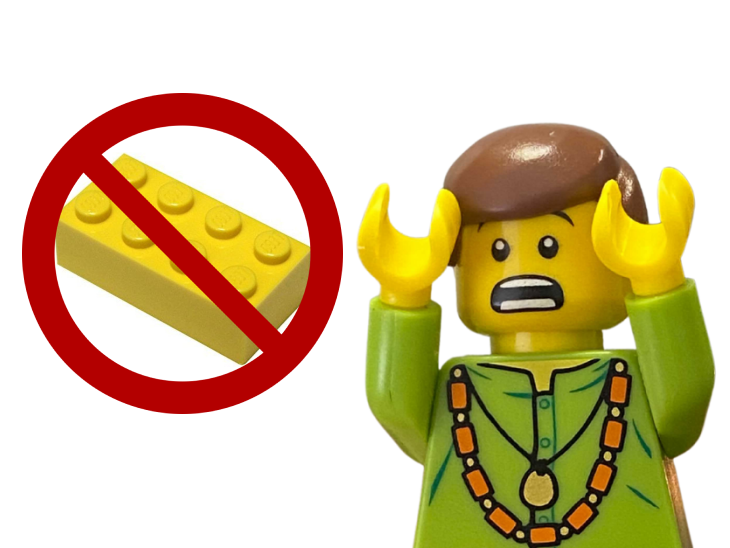Could LEGO Ever Be Banned?
5th October 2023

The recent news that LEGO has scrapped plans to produce bricks from recycled PET bottles, rather than ABS, caused the company to come under some scrutiny. This is because ABS, which around 80% of LEGO bricks are made from, requires 2kg of petroleum to produce 1kg of the stuff. And like many plastics, it's also non-biodegradable. There's no denying, therefore, that LEGO has a huge carbon footprint, despite their commitments to sustainability.
The recent discussion of LEGO's green credentials got us thinking about whether the company's reliance on the material could cause problems in the future in bringing certain LEGO products to the market. So in this article, we summarise three environmental initiatives that could pose a challenge to LEGO.

Microplastics
Microplastics is a term that has gained notoriety in recent years. The legal definition of a microplastic is any particle made from a polymer (plastic) that either has:
- all dimensions of the particles are equal to or less than 5 mm; or
- a length equal to or less than 15 mm and a length to diameter ratio greater than 3.
Just last month the EU adopted a restriction on the use of microplastics that will enter into force on 15 October 2023. This will ban microplastics from being placed on the market.
While there are plenty of tiny LEGO pieces around, fortunately none are quite small enough to fit the microplastic definition. For reference, a standard square 1x1 piece comes in at 7.8mm x 7.8mm.
For now then, LEGO is safe on this front.

Hazardous Chemicals
It might surprise you to learn that plastic can contain hazardous chemicals. Sometimes these are intentionally added to give the plastics certain properties and sometimes they are present at naturally occurring levels.
When the concentrations of these chemicals are too high, they obviously represent a health risk. This is why, in the EU, there are limits on the concentration in which they can be present in plastics.
These limits are set in the EU Toy Safety Directive (TSD) and mainly apply to the group of substances known as CMRs (carcinogenic, mutagenic or toxic for reproduction), which includes substances that cause cancer.
These limits are set at 0.1%, which is was believed to be strict enough to prevent harmful chemicals from being present at unsafe levels to plastic. However, a 2020 review of the TSD recommended that these limits be lowered and expanded to other chemicals of concern to make toys safer.
Currently, there are three policy options on the table to amend the TSD, each of which would grant the European Commission powers to amend the limits or expand them to cover other problematic chemicals. It's possible that the concentration limits could be lowered to a level below which a harmful chemical is present naturally in a plastic, effectively meaning the plastic can no longer be used to make toys. Wooden LEGO anyone?
This is unlikely, given that there is limited evidence that playing with plastic toys harms children's health and there are also no suitable alternative materials that could be used. However, despite this it's still a possibility and we'll find out in due course what the European Commission decides. We should hasten to add that there is no evidence out there that LEGO contains any dangerous chemicals!

Biodegradable Plastics
Only a tiny amount of the total plastics used are biodegradable. This means that when most plastics break down they stay in the environment as microplastics for a very long time. Using a biodegradable plastic would solve this problem but they are hard to produce at scale.
LEGO is also designed to have longevity, so a plastic that degrades wouldn’t be ideal. And a product that’s designed to last is also better than one that isn’t.
At the moment there is no legislation in the EU or US that restricts the use of non-biodegradable plastic and if one does come along, it’s likely to target uses such as packaging first, rather than products.
In summary then, it seems that the future of LEGO is safe for the foreseeable. However, it’s worth keeping in mind the impact of the LEGO you buy and whether you can offset this in any way.

Graham is a passionate LEGO collector, who has a penchant for the Castle, Pirates, and Western themes. You can usually find him monitoring the latest developments and giving his opinion on what's hot and not in the LEGO world.
Comments
Affiliate links
If you found this site useful please consider supporting Brick Ranker by using the affliate links below when purchasing LEGO.
Latest news

LEGO Star Wars Jango Fett's Starship (Slave One) (75409) Box images
Box images of the upcoming Jango Fett's Starship (Slave One) have been revealed. The set, with its 1,000 extra pieces…

LEGO Marvel Iron Man MK4 Bust (76327) and Iron Spider-Man Bust (76326) Officially Revealed
Today LEGO has officially revealed two new Marvel sets the Iron Man MK4 Bust (76327) and the Iron Spider-Man Bust…

LEGO Speed Champions 2 Fast 2 Furious Honda S2000 (77241) Revealed
Today we have a first look at the LEGO Speed Champions 2 Fast 2 Furious Honda S2000 set which is…